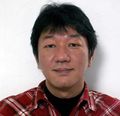Kouji Murata
Kouji Murata is a Japanese composer, sound designer and sound programmer who is best known for his many works at Konami.
Kouji attended Tateishiyama Shiga High School and graduated in 1981. He attended Kinki University for Electronics, but later dropped out. He worked at Freak Ltd. as an instrument repairman. His video game music career started in 1986 when he worked for Tose. As a company policy of not giving credit to their staff, he was never credited in any of the games they worked on. However, his most famous work at Tose was for Bases Loaded, in which his surname appears on the scoreboard. In 1987, he started working for Konami, and was a part of the Konami Kukeiha Club. He composed music, wrote sound effects, and even did sound programming primarily for the company's Famicom and NES titles. He left the company in 1989 and went on to work as a freelance composer. He later worked for Minakuchi Engineering and composed the audio for some of their games. From 1995 to 2010, he ran Yoshidayama-Workshop alongside Kenji Okuda.
Today, Kouji no longer composes video game music, but is currently an Executive Producer for the game developer Bit Groove.
Contents
Music Development
GB
Kouji designed his own sound driver for the games he worked on at Minakuchi Engineering, replacing the previous driver designed by Hiroshi Wada.
Vast Fame stole this driver and used in own GBC and GBA games.
NES
Kouji used a custom sound driver at Tose, and had to write the music in 6502 assembly. For Tenka no Goikenban: Mito Koumon, Kouji listed the game on his website, but said that even though he was assigned to work on the game, the final release of the game has different audio, which he credited to Yoshio Hirai.
At Konami, Kouji initially used Hidenori Maezawa's sound driver, but later developed his own version of the driver, which he used on all the subsequent games he worked on for the company.
(Note: The Bases Loaded 2 soundtrack uses the same title screen music as the first game, but the composer is credited as "Sonoda". Kouji said this is not him, and that he doesn't know about Sonoda.)
TG16
Though Kouji did not actually compose music for the TurboGrafx-16, he did reprogram Video System's sound engine, and talks about it on his archived page:
We reached out to Kouji to ask about the mahjong game, but he did not know the game's title. However, Wai Wai Mahjong was the only mahjong game by Video System for the PC Engine.
WSC
Kouji wrote MIDI files and wrote a tool to convert them to his sound driver. It was also the first console he worked with where he used MIDI files.
Gameography
For Tenka no Goikenban: Mito Koumon, Murata stated on his website that though he was assigned to compose music for the title, the final product featured the music by Yoshio Hirai instead.
| Released | Title | Sample | Notes |
|---|---|---|---|
| 1987-??-?? | Dragon Buster (MSX2) (ドラゴンバスター) | Sound Transplant | |
| 1987-??-?? | Super Lode Runner (MSX2) (スーパーロードランナー) | Sound Transplant | |
| 1987-04-17 | Fuuun Shourin Ken (FDS) (風雲少林拳) | Work Arrangement, Sound Effects | |
| 1987-05-19 | Youkai Club (FC) (妖怪倶楽部) | Work Arrangement, Sound Effects | |
| 1987-05-25 | Pro Golfer Saru: Kage no Tournament (FDS) (プロゴルファー猿 影のトーナメント) | Work Arrangement, Sound Effects | |
| 1987-06-26 | Bases Loaded (NES) (燃えろ!プロ野球) | Work Arrangement, Sound Effects | |
| 1987-08-11 | Arumana no Kiseki (FDS) (アルマナの奇跡) | Arrangement Work One song. | |
| 1987-08-11 | Tenka no Goikenban: Mito Koumon (FC) (水戸黄門) | Composer? Sound Effects? Voice Sampling? | |
| 1987-08-28 | Dracula II: Noroi no Fuuin (FDS) | Sound Driver, Work Arrangement? | |
| 1987-10-02 | Kid Niki: Radical Ninja (NES) (怪傑ヤンチャ丸) | Sound Transplant | |
| 1987-11-?? | Top Gun (NES) (トップガン) | |
With Kiyohiro Sada and Kazuki Muraoka. |
| 1987-12-04 | Dragon Scroll: Yomigaerishi Maryuu (FC) (ドラゴンスクロール) | Sound Drivers/Effects, Work Arrangement | |
| 1988-04-22 | Bio Miracle: Bokutte Upa (FDS) (バイオミラクル ぼくってウパ) | Sound Driver/Effects, Work Arrangements | |
| 1988-06-12 | Risa no Yousei Densetsu (FDS) (リサの妖精伝説) | Sound with Shinya Sakamoto and Hidenori Maezawa. | |
| 1988-10-?? | Bases Loaded 2 (NES) (燃えプロ!!プロ野球’88:決定版) | Title Screen Music | |
| 1988-12-?? | Skate or Die (NES) | Arranged Rob Hubbard's title music, new music compositions. | |
| 1989-01-04 | Ganbare Goemon 2 (FC) (がんばれゴエモン2) | Sound Drivers/Effects, Work Arrangement | |
| 1989-02-?? | Q*Bert (NES) | Arranged David Thiel's music. Sound Transplant, Sound Driver | |
| 1990-10-29 | Rabio Lepus Special (PCE) (ラビオレプススペシャル) | Sound Driver Repogramming | |
| 1992-07-24 | Bionic Commando (GB) (バイオニックコマンドー) | |
Sound Driver/Transplant-Effects, Work Arrangement |
| 1992-12-11 | Mega Man III (GB) (ロックマンワールド3) | |
Sound Driver/Transplant-Effects, Work Arrangement |
| 1993-??-?? | Sengoku Ace (ARC) (戦国エース) | 3 songs | |
| 1993-02-26 | Bio Miracle: I'm Upa (FC) (バイオミラクル ぼくってウパ) | ||
| 1993-10-29 | Mega Man IV (GB) (ロックマンワールド4) | |
Sound Driver/Transplant-Effects, Work Arrangement |
| 1994-07-22 | Mega Man V (GB) (ロックマンワールド5) | |
|
| 1994-10-21 | Mega Man: The Wily Wars (SMD) (ロックマンメガワールド) | Sound Effects | |
| 1995-12-01 | Mega Man X3 (SNES) | Sound Director? | |
| 1998-06-26 | Itsudemo! Nyan to Wonderful (GB) (いつでも!ニャンとワンダフル) | Sound Drivers/Effects, Work Arrangement | |
| 2001-??-?? | Namco Wonder Classic (WSC) (ナムコワンダークラシック) | Sound Driver/Sound Effects | |
| 2001-04-15 | Mr. Driller (WSC) (ミスタードリラー) | Sound Transplant | |
| 2001-04-26 | Hunter X Hunter: Sorezore no Ketsui (WSC) (ハンター×ハンター それぞれの決意) | Sound Driver & Converters | |
| 2001-08-23 | Hunter X Hunter: Michikareshi Mono (WSC) (ハンター×ハンター 導かれし者) | Sound Driver/Adjustment |
Picture Gallery
Links
- facebook.com/kouji.murata.9 - Facebook.
- archive.is/SiEv - Official Gameography (Archived).
- w.atwiki.jp/gamemusicbest100/pages/5149.html - Atwiki.jp (Japanese).


